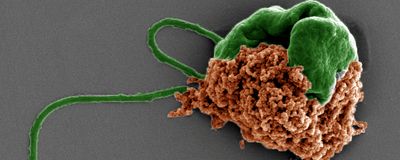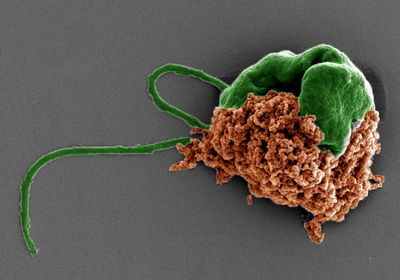ABOVE: Researchers generated biohybrid robots by equipping motile green microalgae cells with drug-filled nanoparticles. Joseph Wang and Liangfang Zhang Laboratory Groups
The lungs are a prominent target for cancer metastasis. Traditional drug delivery methods rely on passive diffusion, but Joseph Wang and Liangfang Zhang, both nanoengineers at the University of California, San Diego, wanted to test active and targeted systems. In a new study, the duo explored the potential of using green algae, Chlamydomonas reinhardtii, as a promising platform for drug delivery because it self-propels, carries cargo on its surface, and is biocompatible.1 “This active propulsion plays an important role in improving the efficacy,” said Zhang.

Their findings, published in Science Advances, described the development of biohybrid microrobots from green algae laden with chemotherapeutic drugs which reduced lung metastasis burden and prolonged survival time in mice.2 Enhancing microalgae with additional functionalities could further improve drug delivery strategies.
“Green algae serve as a mothership,” explained Zhang. “They carry hundreds to thousands of nanoparticles loaded with drug molecules.”
The researchers developed microrobots by chemically attaching nanoparticles (NP) to the surface of the algal cells. The nanoparticles were biodegradable polymer spheres filled with the chemotherapeutic drug doxorubicin (DOX) and coated with red blood cell membranes [NP(DOX)]. This cell membrane coating shielded the drug payload from the immune system.
Then, the team characterized the algae-NP(DOX)-robots and used fluorescent and scanning electron microscopy to confirm that the nanoparticles successfully hitched a ride onto the microalgae. When comparing NP(DOX) and algae-NP(DOX)-robots, the microrobots more effectively inhibited cancer cell growth and proliferation.
Next, they tested the biorobots’ therapeutic efficacy in mice over time. “When you dose these to the lungs…this robotic system will be activated as they start to swim in the lung fluid,” explained Zhang. They administered mice with 70 microgram of a 75 microgram dose of DOX to the lungs and found that more of the drugs from the algae-NP(DOX)-robots remained in the lungs after 24 hours.

The next challenge was to determine how the microrobots would be cleared from the body. After 24 hours of incubation with murine alveolar macrophages, only 25 percent of DOX from algae-NP(DOX) microrobots was absorbed, compared to 70 percent from nanoparticles. Researchers suggest that the microalgae’s motility enabled deeper lung penetration and extended drug retention.
Then, they tested microrobots on mice with lung-metastasized melanoma by administering four 75 microgram DOX doses over a week. Bioluminescence results indicated that algae-NP(DOX) microrobots inhibited metastasis more effectively and extended the median survival from 27 to 37 days compared to free drug or NP(DOX) alone.
“Biohybrid [technology] is exciting because they’re living drugs. They can respond to their environment…it definitely has huge potential,” said Yunus Alapan, a bioengineer at the University of Wisconsin-Madison, who was not involved in the study. He noted his excitement toward this convergence of robotics and biology to create microrobots to respond to different microenvironments.
Wang and Zhang plan to test the scalability of these microrobots and explore their therapeutic benefits in larger animal models. Additionally, they are investigating other algae, including extremophiles that thrive in harsh conditions, to tailor the diverse properties of algae to specific applications. “The possibilities are unlimited. Just imagine a multifunctional Swiss knife [microrobot] that is 20 micrometers…all without any battery or electronics,” remarked Wang.
- Zhang F, et al. Nanoparticle-modified microrobots for in vivo antibiotic delivery to treat acute bacterial pneumonia. Nat Mater. 2022;21(11):1324-1332.
- Zhang F, et al. Biohybrid microrobots locally and actively deliver drug-loaded nanoparticles to inhibit the progression of lung metastasis. Sci Adv. 2024;10(24):eadn6157.




